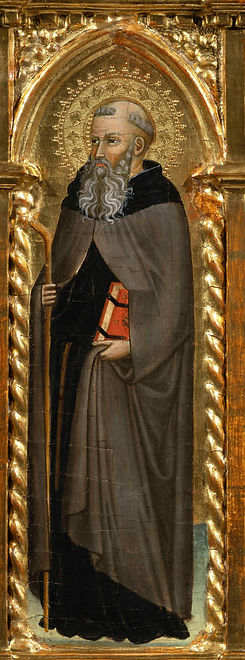FG FINE ART LTD

Cecco di Pietro
Active in Pisa from 1371 to 1402
The three Saints were promptly identified by Miklós Boskovits as the work of Cecco di Pietro, a Pisan artist who enjoyed undisputed success and a prominent position in Pisa in the last quarter of the 14th-century.
These little panels have been recognised with certainty as being part of the Agnano polyptych, preserved in the museum of Palazzo Blu and part in the museum of San Matteo both in Pisa, and considered the main work produced by Cecco.
Cecco di Pietro started his career under the influence of Giovanni da Milano, which had a minimal impact on his style, to then closely aligne with Francesco Neri da Volterra, with which he collaborated in 1371 at the Camposanto in Pisa.

A Saint Bishop, Saint Anthony the Abbot, and a Saint Pope (Gregory the Great?)
c. 1375-1380
Tempera on panel, 46 x 33 cm
Provenance
Agnano (Pisa), Olivetan Church of Saint Jerome
New York, Mrs Albert E. Goodhart, bequeathed in 1952 to
New York, Robert Lehman (1891-1969)
New York, private collection, since 1960 c.
Exhibitions
New York, The Cincinnati Art Museum, The Lehman Collection, May 8 - July 15, 1959, n. 78
Bibliography
The Lehman Collection. New York, exhibition catalogue, Cincinnati 1959, p. 17
M. Boskovits, Cecco di Pietro, in Dizionario Biografico degli Italiani, 23, Roma 1979, p. 285
M. Burresi, Il polittico di Agnano nel percorso di Cecco di Pietro, in R. P. Ciardi, A. Caleca, M. Burresi, Il polittico di Agnano. Cecco di Pietro e la pittura pisana del ‘300, Ospedaletto 1986, p. 79

Reconstruction of the Agnano Polyptych
(L. Pisani 2011, graphic elaboration by D. Sallay and G. Buzàs)
with the addition of the Saint Anthony the Abbot on the pillar and the Saint Bishop and the Saint Pope on the predella
The panel illustrating Saint Francis Receiving the Stigmata encompasses several distinctive elements of Cenni di Francesco’s figurative style. The episode is recounted with an abundance of detail, a hallmark of this artist. The depiction of La Verna’s rugged and remote landscape occupies a significant portion of the composition. The artist meticulously portrays the architecture of two convents in the background, the trees, the crevices in the rocks, and even the grain on a wooden plank laid as a pathway along the precipice. The warm tonalities of the colour palette are bathed in the light that falls upon the rocks, the tunic, and the serene, almost smiling countenance of Saint Francis.


Undoubtedly, the Saint Bishop and the Saint Pope on the sides of our triptych were part of this grand structure, albeit they differ significantly in size from Saint Anthony the Abbot and the other saints. It has never been noted, until yet, that their height closely matches that of the figures on the Pisan polygonal bases – certainly from Agnano – suggesting they were originally designed to rhythmically accentuate the compartments of the predella in the Olivetan polyptych, which also presents an analogous vertical format, as enhanced by the scale reconstruction.
Supporting this, the white garments visible beneath the copes, which are also worn by the central register’s male in the polyptych in Palazzo Blu, align well with the Olivetan context. Moreover, their stoles, marked with parallel horizontal incisions, analogous to those on the mantle in the Foresti panel, match the ornamentation on the celebrants’ garments in the Funeral of Saint Benedict at the Musée des Beaux-Arts in Dijon, a predella compartment long associated with the Agnano polyptych, featuring similarly adorned halos on the Saint Bishop and the Saint Pope. The Agnano altarpiece is widely acknowledged as Cecco di Pietro’s most challenging work, commissioned for the Olivetan church established by the Archbishop of Pisa, Giovanni Scarlatti, in 1360. His monogram, in fact, appears on the shields in the upper register of the polyptych, alongside the Del Testa family’s coat of arms. Linda Pisani’s research has uncovered a considerable endowment for the Abbey of Agnano’s main altar by Bartolomeo di Betto del Testa in 1374, providing a crucial clue for the chronology of the polyptych, for a long time placed in the later activity of the master’s career.
A full fact sheet is available on request.